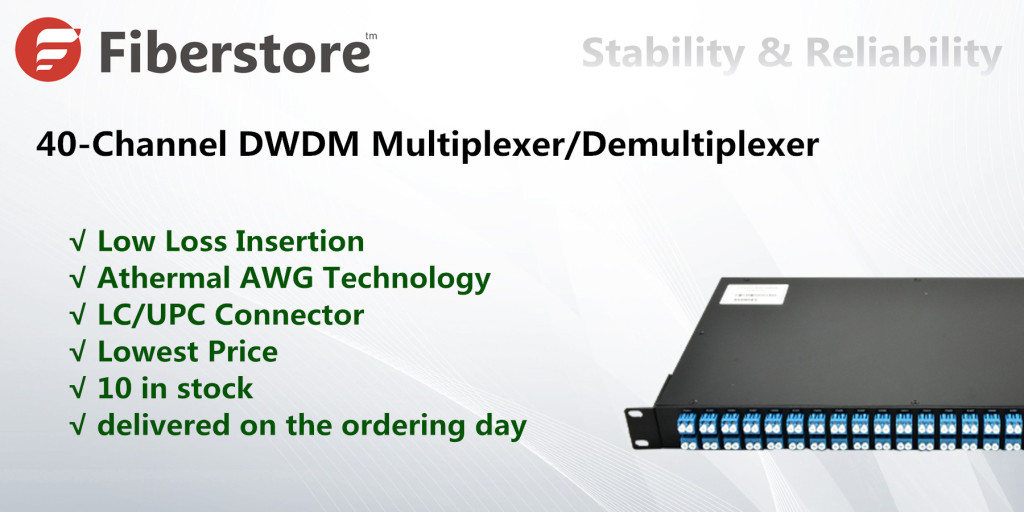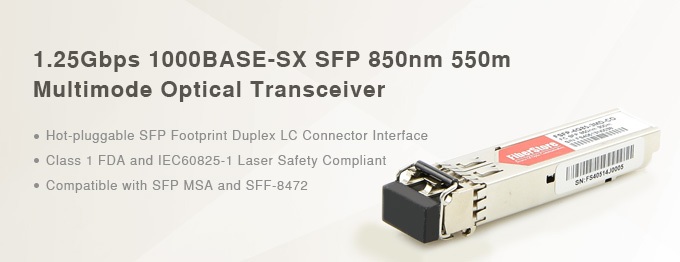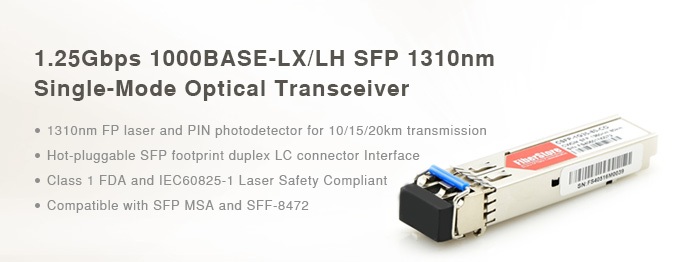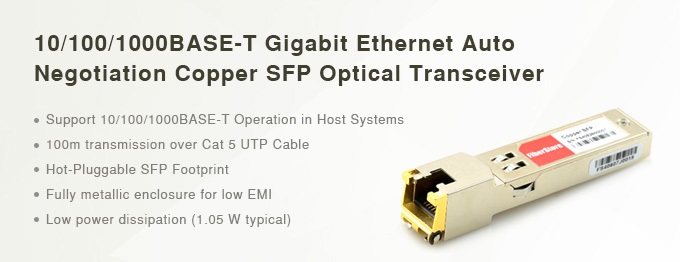Share Various Fiber Optic Telecom Network Topics, Information, News, Questions, Sources and Network Solutions.
Wednesday, June 24, 2015
FAQs You May Ask When Using 1000BASE-LX/LH SFP
Q1: Can 1000BASE-LX compatible with 100BASE-LX?
A1: 1000BASE-LX and 100BASE-FX are very different standards. 1000BASE-LX SFP (GLC-LH-SMD) and 100BASE-LX SFP (GLC-FE-100LX) are 2 module types, one for GE and one for FE slots. The GLC-LH-SMD will not operate at 100Mbps. You will need to use a 100Mb module to connect to another device at 100Mb. Check optical transceiver compatibility with your equipment by reviewing the Cisco Fast Ethernet SFP module compatibility document and choose the one it says is compatible.
Q2: What is the difference between LH and LX modules?
A2: Long Haul (LH) denotes longer distances while Long Wavelength (LX) denotes less energy which is obviously shorter distance. Before it was standardized 1000BASE-LX10 was essentially already in widespread use by many vendors as a proprietary extension called either 1000BASE-LX/LH or 1000BASE-LH.
Q3: Does 1000BASE-LX SFP work with 1000BASE-LH SFP? What does it infer if a module says like "Cisco 1000BASE-LX/LH SFP"?
A3: Yes, the 1000BASE-LX will work with the 1000BASE-LH. For instance, Cisco 1000BASE-LX/LH SFP is either made for single mode (long distance) / multimode (short distance). But this module can be used for both Single-mode and Multimode. The Cisco 1000BASE-LX/LH SFP, compatible with the IEEE 802.3z 1000BASE-LX standard, operates on standard single-mode fiber-optic link spans of up to 10 km and up to 550 m on any multimode fibers. When used over legacy multimode fiber type, the transmitter should be coupled through a mode conditioning patch cable.
Q4: What about Mode Conditioning Patch cords (MCP)?
A4: When selecting an optical transceiver, watch the transceiver’s user documentation for when a MCP should be used (see previous link for MCP information). They are sometimes required when your network’s installed optical cable is OM1 or OM2 rated multimode fiber (MMF). In short, the MCP is an optical jumper that transitions the transmit fiber from a single mode fiber (SMF) to a multimode fiber.
Q5: GLC-LH-SM SFP to 1000BASELX GBIC won't link over MMF?
A5: Cisco compatibility document says: "Some customers might be tempted to connect 1000BASE-LX/LH devices over short reaches of MMF jumper cables without MCP cables. There is a risk associated to this type of nonstandard deployment, especially when the jumper cable is an FDDI-grade or OM1 type. In such case the power coupled directly into a 62.5-micron fiber could be as high as a few dBm (typically 5 to 6 dBm), and if the jumper cable is short, the adjacent receiver will be saturated, causing high bit error rate, and eventually irreversibly damaged. We recommend the use of MCP, but if the customer remains reluctant to the deployment of MCP, a 5-dB attenuator for 1300nm should be used and plugged at the transmitter of the optical module on each side of the link."
Q6: Does GLC-LH-SMD working with GLC-LH-SM?
A6: Yes. Both the GLC-LH-SM and GLC-LH-SMD transceivers support the IEEE 802.3 1000BASE-LX/LH standard and so are compatible with each other. The difference between the two is that the GLC-LH-SMD transceiver has additional support for Digital Optical Monitoring capability.
Q7: How much bandwidth can my single mode fiber (SMF) support?
A7: Single mode fiber has an extremely large bandwidth capacity. The following diagram shows how bandwidth can be scaled on SMF. Scaling bandwidth on fiber is not inexpensive. Depending upon the network, it may be more cost effective to install additional fibers instead of adding WDM technology.
Click through to browse GLC-LH-SMD price
Reference: www.sfp-transceiver-modules.com
Warm Tips: Fiberstore offers amount of in-stock 1000BASE-LX/LH SFP which are compatible for Cisco, Juniper, Dell, Finisar, Brocade, or Netgear (AGM732F) in 10/20 Km options.
Thursday, June 18, 2015
Do Not Miss Fiberstore's 40-Channel DWDM Mux/Demux
Since the start of DWDM, various equipment and technologies have been used to enhance the high performance of every part in DWDM network. DWDM Multiplexer and demultiplexer are the main equipment that take charge of the data sources' multiplexing and demultiplexing. In the past years, DWDM multiplexers and demultiplexers have been upgraded rapidly to overcome the insertion loss and to meet the demands of the increasing requests for faster telecommunication, and they are always being combined in one rack by today's vendors also known as DWDM Mux/Demux.
Fiberstore as a serious manufacture of optical communication published a 40-channel Duplex DWDM Athermal AWG Mux/Demux with competitive features which are described as following:
- Low Insertion Loss: Insertion loss is an inevitable problem in optical networks. Combining LC/UPCconnectors of high quality and AWG technology, this duplex Mux/Demux reduces the insertion loss to a minimum of 3dB and increases the transmission capacity effectively.
- Athermal AWG Technology: With athermal design this mux/demux device is temperature-intensive and allows multiplexing and demultiplexing of DWDM signals over a wide operating temperature range with long-term stability, reliability and large transmission capacity.
- Large Channel Number & Excellent Channel Isolation: This DWDM Mux/Demux is designed for use within the C-band release of DWDM system which uses 40 channels at 100GHz spacing containing the channels from C21 (wavelength: 1560.606 nm) to C60 (wavelength: 1529.553 nm). Also 1.6nm (200 GHz) are available on request. Excellent channel isolation that eases the fiber handling is also provided.
- Space saving: With a standard 19 inch rack mount housing size, this DWDM Mux/Demux saves space effectively.
- High quality and Inexpensive: The products of Fiberstore has been appreciated by customers for its reliable quality. Comparing with other manufactures, Fiberstore offers the lowest price for such a high quality 40-channel DWDM Mux/Demux.
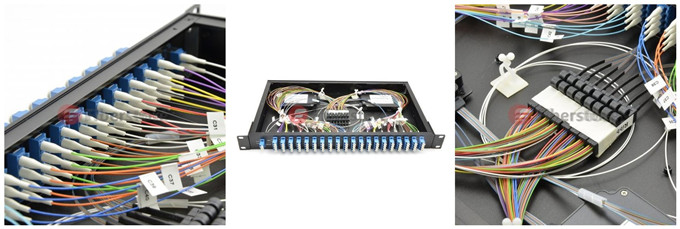
Click through to get more information about WDM fiber optic multiplexer.
Wednesday, June 17, 2015
1.25G SFP Transceiver Alternative Solution
| Module # | Data Rate | Transmission Distance | Connector Type | Price | Inventory |
| 1000BASE-SX SFP Transceiver | ≤ 1.25 Gbps | 550 m | LC | US$ 8.00 | 2000 |
| 1000BASE-LX/LH SFP 1310 nm Transceiver | ≤ 1.25 Gbps | 10/15/20 km | LC | US$ 10.00 | 5500 |
| 10/100/1000BASE-T SFP Transceiver | 10/100/1000 Mbps | 100 m | RJ45 | US$ 18.00 | 1000 |
Sunday, June 14, 2015
Great Compatible Cisco 10G SFP+ Modules
SFP+ is the Most Popular 10G Transceiver Module
Common 10GbE Standards for SFP+
| Cisco compatible SFP+ | Cable Type | Wavelength | Max Range |
|---|---|---|---|
| 10GBASE-SR SFP | MMF | 850nm | OM3:300m/OM4:400m |
| 10GBASE-LR SFP | SMF | 1310nm | 10km |
| 10GBASE-LRM SFP | MMF | 1310nm | 220m |
| 10GBASE-ER SFP | SMF | 1550nm | 40km |
| 10GBASE-ZR SFP | SMF | 1550nm | 80km |
Two Kinds of Compatible Cisco SFP+ Transceivers from Fiberstore
-
SFP-10G85-3M-CO
The SFP-10G85-3M-CO series multi-mode transceiver is a SFP+ module for duplex optical data communications such as 10GBASE-SR and 10GBASE-SW. This transceiver offers the same function with Cisco 10G SR SFP and is fully compatible with Cisco devices. It is a hot-swappable input/output device, which means no need to power down if installing or replacing. Its transmission distance can up to 300m with duplex LC multi-mode Fiber cable.
-
SFP-10G31-10-CO
The SFP-10G31-10-CO single mode transceiver is a small form factor pluggable module for serial optical data communications such as IEEE 802.3ae 10GBASE-LR/LW. This 10GBASE-LR SFP module offers the same function with Cisco SFP-10G-LR and is fully compatible with Cisco devices. This module is designed for single mode fiber and operates at a nominal wavelength of 1310 nm. Its transmission distance can up to 10km with duplex LC single-mode fiber.
Monday, June 8, 2015
What You Need to Know When Using 10G over CWDM
Bandwidth Exts are Easier
In past years, designers who want to increase or improve their bandwidth could achieve this easily over a single or duplex mode fiber. During this period, the 1G Ethernet and CWDM solutions were sufficient, and the only limiting element was the power budget of the optical transceiver or the attenuation of your fiber. That it was possible to transmit up to 200 kilometers and utilize just a 1G Ethernet when designers preferred cheap CWDM.
Now, many people are considering the 10G Ethernet solutions, and that's why it's necessary to understand how everything will differ when using 10G over CWDM. When intending to migrate to 10G, you need to know the fiber type. For the dispersion and attenuation calculation, every designer need to know the recommended parameters from ITU-T and understanding the vendor and product kind of the fiber could also help. Remember that the physical fiber will work better than the standards claim most of the time.
Chromatic dispersion is referred to as the time variance of a single pulse of a signal. To summarize, chromatic dispersion is "the spreading of a light pulse per unit source spectrum width in an optical fibre due to the various group velocities of the different wavelengths composing the source spectrum" or in layman's terms, "the signal is stretched on the fiber transmission path due the dispersion characteristics of the transporting fiber."
Chromatic dispersion always exists, but the higher the link speed is, the greater important it becomes. For instance, a wavelength of 1310nm have a 0 ps/nm chromatic dispersion and 5, 25 dB fiber attenuation. In comparison, a wavelength of 1610 nm have a 330 ps/nm chromatic dispersion and a 3,45 dB fiber attenuation.
CWDM Over DWDM 10G is Cost-Effective
Designers should bear it in mind that CWDM implementation is more cost effective than passive DWDM infrastructure. These solutions will be more expensive because DWDM lasers cost more. DWDM lasers are essentially DFB lasers which are cooled, however, they are recommended as they contain the longevity that are required in these solutions. If you would like transmit a signal over a large distance, you should think about large metro ring topologies.
Though 10GBASE DWDM is more expensive, it's become the first choice because users have started to consider the costs after dividing it over the quantity of customers served. Some customers are more cost-conscious and have lower bandwidth capacity requirements; so, the cheap CWDM infrastructure will make more sense.
Remember that the new 10GBASE DWDM services is usually added over the same fiber. This will enhance the support of the initial CWDM infrastructure capacity by 4 times. This is irresistible to many designers.
Select A Reputable Brand
Selecting a reputable brand for your CWDM Solution is necessary to achieve the best results. When you select a reputable brand, which means that multiple customers have had a favorable experience with this brand, this means that you’re likely to have success with the brand also. Compatible CWDM SFP, CWDM optical multiplexer and add drop CWDM all of these device you can but these form Fiberstore.Inc, which offer warranties and other benefits, also have an option for longer service and support.
Wednesday, June 3, 2015
How to Use DOM in Cisco System
Do you know that there is a fiber tester inside your optical transceiver? This "fiber tester" we call it DOM, which is short for Digital Optical Monitoring. DOM is a feature which enables the monitoring of some interesting status values on the interface with the most useful values being the optical receive and transmit powers. You can configure your Cisco (or other brand) device to monitor optical transceivers in the system, either globally or by specified port(s). When this feature is enabled, the system will monitor the temperature and signal power levels for the optical transceivers in the specified port(s). CONSOLE messages and SYSLOG messages are sent when optical operating conditions fall below or rise above the optical transceiver manufacturer’s recommended thresholds. By being able to monitor transmit and receive power levels of optical interfaces you are able to characterize the fiber loss and isolate any unidirectional connectivity issues. So, how to use DOM for your optical transceiver in Cisco system is our main topic today.
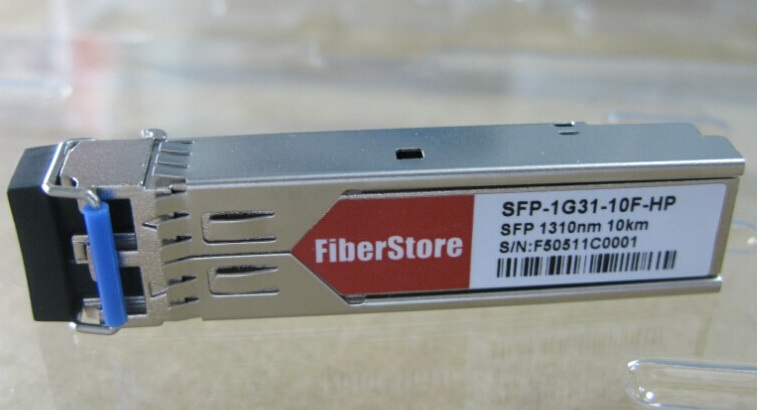
DOM allows to monitor some parameters so that network administrators can then check and ensure that the module is functioning correctly. These real-time operating parameters include:
- Optical Tx power
- Optcal Rx power
- Laser bias current
- Temparature
- Transceiver supply voltage
- Ensure that your optical transceiver supports DOM. For Cisco original optical transceivers, you need the transceiver module compatibility information for configuring transceiver monitoring.
- In case of combo ports with SFP and RJ45 provision, when SFP is inserted in slot or port and media type is not configured to SFP, DOM is functional only if global transceiver monitoring is enabled.
- CISCO-ENTITY-SENSOR-MIB traps are sent only once after the threshold violation. However, SYSLOG traps are sent according to the monitoring interval.
| Command or Action | Purpose | |
| Step 1 | enableExample: Router> enable | Enables the privileged EXEC mode.• Enter your password if prompted. |
| Step 2 | configure terminalExample: Router# configure terminal | Enters the global configuration mode. |
| Step 3 | transceiver type allExample: Router(config)# transceiver type all | Enters the transceiver type configuration mode. |
| Step 4 | monitoringExample: Router(config-xcvr-type)# monitoring | Enables monitoring of all optical transceivers. |
| Step 5 | monitoring intervalExample: Router(config-xcvr-type)# monitoring interval 500 | (Optional) Specifies the time interval for monitoring optical transceivers. Valid range is 300 to 3600 seconds, and the default value is 600 seconds. |
In conclusion, there are three main command that can be used to turn on/off DOM for all transceivers type in the system:
- Router(config)#transceiver type all
- Router(config-xcvr-type)#monitoring
- Router(config-xcvr-type)#end
Once enabled, DOM can be accessed via CLI using "show interface transceiver command", shown as the following picture:

DOM is incredibly handy when troubleshooting fiber issues. A low value in the Rx Power column indicates that you have a bad fiber, or more commonly, a dirty fiber optic patch cable somewhere.
Of all the five values, two mostly used and relevant values are TX and RX power, and temperature is also used sometimes. The operating range of these three values is unique across all modules and is available in the data sheet. Additionally, there is an extension available for this command, which is also very helpful and is used to check threshold values of the above parameters like temperature, Tx and Rx. The command is "show interface gig x/y transceiver detail".
Though DOM is a very helpful functionality of optical transceiver, not all transceivers support DOM in Cisco's optical transceiver products family. For example, the common SFPs, such as the GLC-LX or GLC-SX units that are used by most network engineers on a day to day basis are not with DOM feature.
Why not add this helpful and convenient feature to all transceivers? Actually, Cisco have their own attitude. They think that DOM functionality is worth an extra $300 a pop, putting the cost of a DOM-enabled single mode SFP close to $800. However, DOM functionality is not a novel thing now. Surprisingly, there are some third-party optical transceiver include the DOM functionality but with a low cost. Fiberstore, for instance, as the professional optical transceiver manufacturer and supplier, they can offer Cisco compatible SFP transceivers with DDM or DOM functionality with a low cost. For example, GLC-LX-SM-RGD offered by Fiberstore just at $18.00, GLC-SX-MMD and GLC-LH-SMD at $10.00. But if we want to use non-Cisco transceivers, we need a little different approach to get started with DOM of non-Cisco transceivers. To enable support for non-Cisco SFPs, command "Router(config)#service unsupported-transceiver" is necessary.
Originally published at www.fiber-optic-transceiver-module.com.
